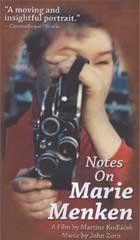
Notes on Marie Menken 2006
Distributed by First Run/Icarus Films, 32 Court St., 21st Floor, Brooklyn, NY 11201; 800-876-1710
Producer n/a
Directed by Martina Kudlacek
VHS, color and b&, 97 min.
College - Adult
Film Studies, Gay and Lesbian Studies
Date Entered: 09/24/2004
Reviewed by Oksana Dykyj, Head, Visual Media Resources, Concordia University, MontrealFinally, there is more than a footnote on Marie Menken, a Lithuanian immigrant (Menkevikas) who was part of American experimental film in New York from the 1940s to the 1960s. Several films about pioneer experimental filmmakers like Maya Deren and Stan Brakhage now exist, but Marie Menken, among other women artists from the mid-20th century, need to be acknowledged and their films viewed. This is an excellent way to introduce Menken to those who do not know her and to rekindle a friendship for those who remember her but who have not seen her films in years. Filmmaker Martina Kudlacek had the good sense to include a good number of lengthy clips from Menken’s film work, material that is almost completely unavailable today, and being unavailable and inaccessible is anathema to an artist’s legacy, particularly when much of the work is as ephemeral as 16mm film.
Kudlacek gets good interviews from painter Alfred Leslie who relates how Menken’s formal ideas found relish in the multimedia art objects she produced and delves into her fascination with light. He also discusses her long and stormy marriage to gay poet/filmmaker Willard Maas over an excerpt from Maas’ film Narcissus. Menken and Maas were actually the models for the characters of Martha and George in Edward Albee’s Who’s Afraid of Virginia Woolf. Artist filmmaker Peter Kubelka discusses the tactile dance event that goes on between a filmmaker and her camera as a clip of Menken’s Lights is shown. Kenneth Anger discusses his relationship with Menken and how she made Arabesque for Kenneth Anger which is shown in almost its entirety. In fact, the music for Arabesque is by John Zorn who collaborated with Martina Kudlacek to provide the music for her film on Menken. Stan Brakhage, who died before this film was made, is seen in footage where he scratched film emulsion for his work while the soundtrack plays sections of his 1976 lectures on hypnagogic films.
The most gripping interview is with Gerard Malanga, Andy Warhol’s assistant and unheralded collaborator. His memory of interactions between Menken and Warhol is astute and the section where he places a badly deteriorated print of Menken and Warhol both filming each other and moving around on a rooftop like dancers dueling with their Bolex cameras, is the most compelling in the film. Additional excerpts include Menken’s Andy Warhol, Glimpse of a Garden, and Go!Go!Go!
While some archival footage is not identified and years are not always provided for films, most likely because they were always works in progress, the film is well crafted if at times a bit too self-conscious in its attempt to segue into Menken’s work through Kudlacek’s “recreations.” However, this film is a necessity for anyone who is interested in the artist who most influenced Stan Brakhage and helped Kenneth Anger during Scorpio Rising. Highly recommended.